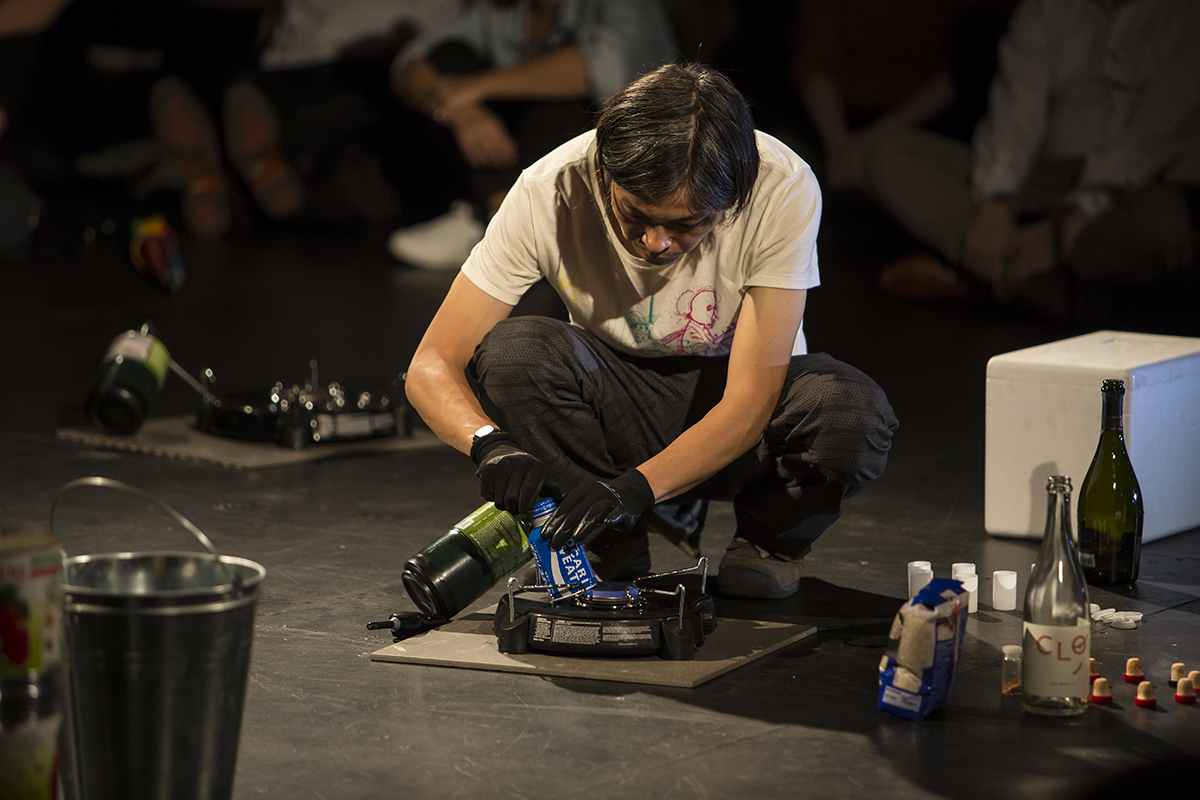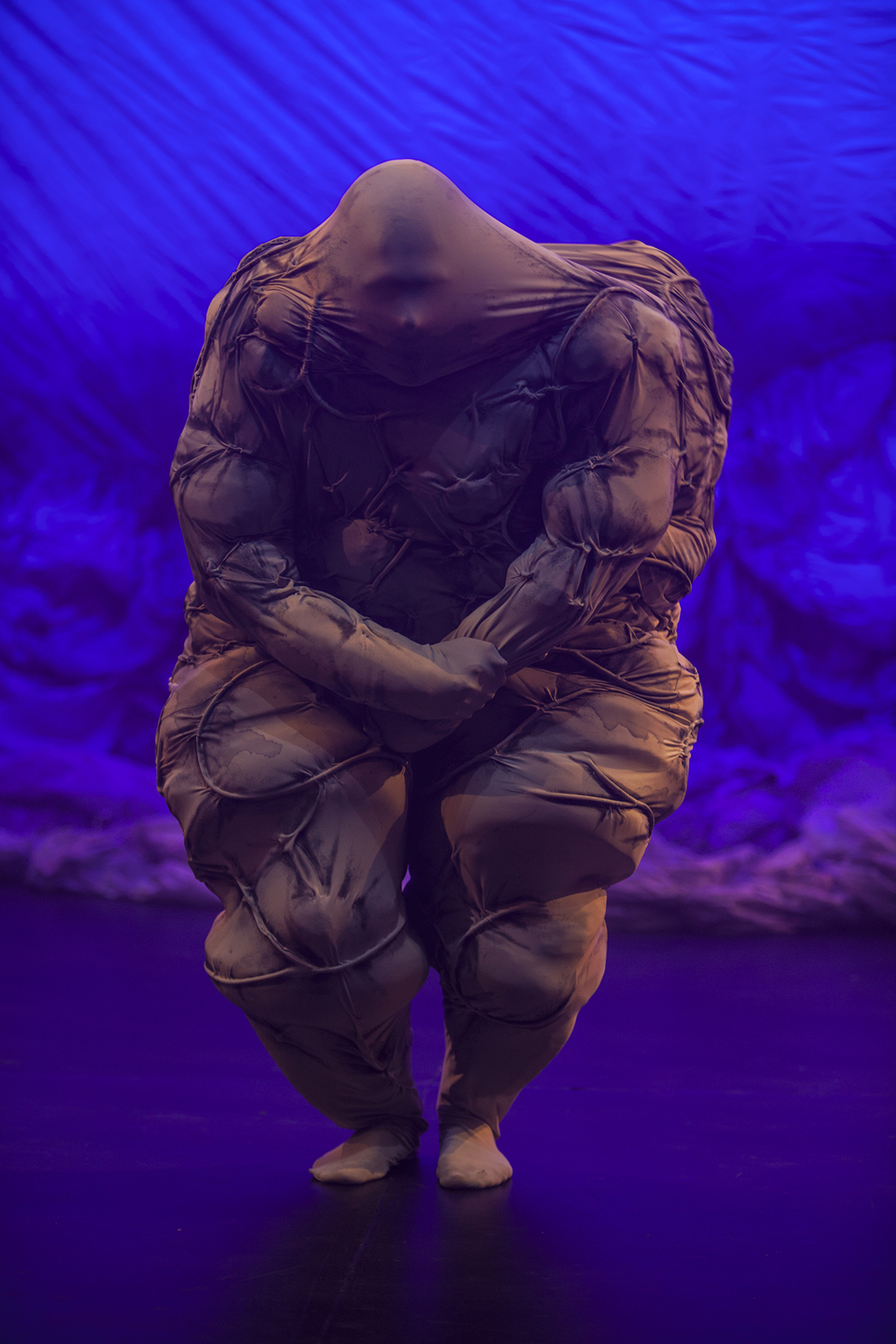
Putting Liveworks to the test
Once again Liveworks provided us with a concentrated gathering of Australian and Asian performance constellated around the notion of experimental arts — the kinds of mind- and formula-bending works we’re desperate to see at Carriageworks year-round. Works this year proved to be experimental to greatly varying degrees — sometimes simply evoked as such, sometimes actual. A virally pervasive preoccupation with transformation, thematic and formal, offered clues as to how we might test for experimentalism.
Anthropomorphising tools domestic and industrial, Geumhyung Jeong became, on her own terms, an hermaphrodite. Jen Jamieson artfully elevated her participants’ hormonal functioning. Mark Harvey altered the nature of conversation by challenging its physical conventions. Agatha Gothe-Snape “transmitted” Laurence Weiner’s conceptual art texts such that they became song (and much else). Eisa Jocson revealed the means for her transformations into pole dancer, macho dancer, hostess and Snow White. Justin Shoulder emerged from one monstrous body and mutated into another. Christian Thompson manifested as elusive versions of himself. Lz Dunn turned her participant audience and performers in AEON into a bird-like flock. LabAnino made Australia and the Philippines one in a performative installation. Tetsuya Umeda played magician, drawing unlikely sounds and images from seemingly ordinary ingredients. Nat Randall transformed us into obsessive observers, hooked on repetition and seeking telling variations in male behaviour in The Second Woman.
Of course, transformation is one of art’s commonest themes, but we largely look to changes in form for signs of innovation and evidence of the experimentation to which Liveworks lays claim. One-on-one works across the last decade have generated numerous performative possibilities, engaged intimately with topics often unlikely to be dealt with in theatres (see our review of the 2017 Proximity Festival) and made members of the public ephemeral co-creators. Nat Randall’s innovation is to have taken the private one-on-one model and made it simultaneously a theatrical experience. Male participants have spoken of how little sense they had of the audience because the room in which they met Randall was so self-contained. The Second Woman exudes a sense of experiment, with its 100 samples over 24 hours (the men I called lab rats in my first review of Liveworks), a strict methodology, performer endurance witnessed by audiences often staying over many hours, all heightened with intimate camera close-ups.
Mark Harvey’s Helping Hand — a mix of one-on-one and group conversations in various spots in and around Carriageworks — also evoked experiment, one doggedly exercised across the two weeks of Liveworks. Video documentation and an artist’s report on how his chance participants responded to his amiable presence and physical discomfort (eg lying down on stairs headfirst while conversing) might make for interesting sociological study in the tradition of Erving Goffman’s investigations into everyday behaviour. Not that such a report is necessary, but like much innovative art today Helping Hand prompts that kind of R&D thinking.
The experiment that is Jen Jamieson’s Let’s Make Love has been encouraged by recent scientific research about self-generated oxytocin’s influence on our sense of wellbeing. The outcomes are necessarily impressionistic but, as with any artwork it’s the degree to which those feelings are shared in post-one-on-one word of mouth that determines if the experiment has worked or not. Lz Dun’s AEON, also inspired by scientific research, had participants mimicking bird behaviour in a work that says much about our own at a time when the human/animal divide is steadily eroding and biomimicry is vital to our future. In these two works, form and content appear to be satisfyingly in synch, however nebulous the outcomes — feelings, impulses, urges (see Cleo Mees’ account of AEON).
Eisa Jocson (Corponomy) and Geumhyung Jeong (Oil Pressure Vibrator) took the lecture-performance model up a notch with their carefully calibrated, personal accounts of vision and the process for its realisation. Jocson’s was quite political, Jeong’s more personal, both delivered precisely and with an air of almost clinical detachment (until Jocson became Snow White and Jeong lay spasming before a screen image of an earthmover probing a sand model of her naked body), each evoking an investigative science of performance. In her review of Jeong’s performances Nikki Heywood applauds the artist’s obsessive artistry and the rigour of her process.

CARRION, Justin Shoulder, photo Alex Davies
Justin Shoulder’s CARRION, a personal account of stages of human/animal evolution if without Darwinian logic, was strikingly imaginative. Shoulder and his collaborators’ design sense is superb. As Cleo Mees writes, there is “a profound melding of costume and body, a mutual transformation which produces creatures that feel real, through and through.” However, while Shoulder’s experiments in design are undeniably ingenious and his movement skills strikingly improved since I last saw his work, CARRION remains a series of images that don’t cohere. A creature is birthed from a carapace, sits in the dark transforming at length into an indigenous male figure (why are we not to see this?) and is absorbed into a huge gut-like inflatable, his head impossibly poking minutely from a pulsing protuberance. The carapace becomes the body of a monstrous beast which emu-like inspects its terrain and dances its way to apparent extinction. Transformative images and movement (when not interrupted by inexplicable wanderings) are memorable and the sense of a dark, maturing vision palpable, but the work is not compellingly organic, rather it recalled an older model of contemporary performance, as did Agatha Goethe-Snape’s Rhetorical Chorus and Christian Thompson’s Tree of Knowledge, works fascinating in themselves but falling short of experimental.
New to Liveworks this year were two keynote addresses. Tang Fu Kuen, a renowned dramaturg, curator and now Artistic Director of the Taipei Arts Festival, and r e a, a leading Australian media artist. Tang’s overlong address (leaving little time for discussion) focused on the challenges he faces in leading a very large arts festival and dealing with a huge, not yet completed art venue, one of many of such scale that are springing up across Asia ready to house major performances, often without considering the profusion of smaller, innovative works. We learned little of the kinds of work Tang will program at a moment when we’re fascinated with innovative and experimental Asian performance and its connections with Australia through Liveworks, OzAsia and Asia TOPA. R e a delivered a succinct, deeply personal account of her emergence into experimental media practice in terms of her engagement with technology, her Aboriginal heritage and the challenges that come with being adequately acknowledged (if at all) in visual arts discourse simply as an “Aboriginal media artist.” Performance Space needs to rethink the staging of these talks in terms of its experimental credo and build an audience for them.
Either we accept “experimental” as an umbrella term for contemporary performance, live art, one-on-one performance, performative installation, relational works et al, or we get serious about it. Performance Space needs to engage its public in a discussion about the rationale for the festival’s being. Its audiences are the intelligent, supportive subjects of its experimental testings. Q&As for individual works don’t have the scope. During Liveworks, the Australia Council for the Arts and Performance Space held a very welcome one-day forum on experimental performance for practitioners from around Australia and several international guests. Unfortunately, I couldn’t attend, but it prompted thoughts of such a forum shared in part with the Liveworks audience and, far more important, another which, late in the festival program, would draw together Artistic Director Jeff Khan, artists and audience in a substantial discussion on the state and calibre of experimental art as evidenced by the current festival. That would be serious.
–
Performance Space, Liveworks Festival of Experimental Art, Carriageworks, Sydney, 19-29 Oct
Top image credit: Ringo, Tetsuya Umeda, photo Alex Davies






